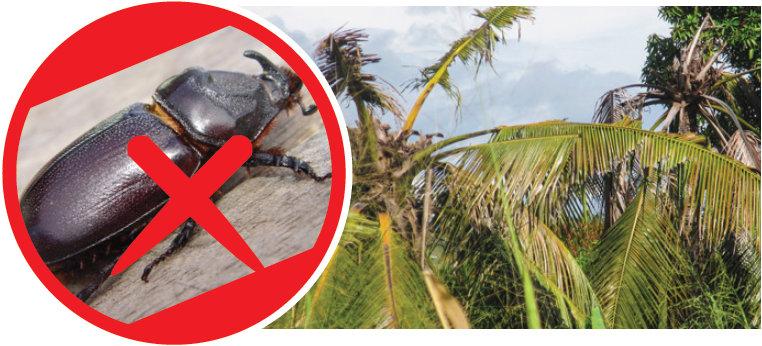An imminent threat to Pacific livelihoods and economies reliant on coconuts; oil palm and other palm species, has been identified. A new biotype of Coconut rhinoceros beetle (CRB), Oryctes rhinoceros was first discovered in Guam in 2007.
This biotype known as CRB Guam (CRB-G) is highly invasive with the ability to cause significant damage and to rapidly adapt to its environment. Since its discovery, new invasions have been recorded on the Papua New Guinea (PNG) mainland (2009), Hawaii (2014), Palau (2014) and Solomon Islands (2015).
Background:
The CRB Guam is resistant to known isolates of the Oryctes nudivirus (OrNV) which had previously proven effective against the CRB-Pacific (CRB-P) biotype.
A study of palms in CRB ‘hot spots’ with uncontrolled breeding sites yielded the following comparative results between the CRB-P and CRB-G biotypes: CRB has a long life cycle of around 180 days. The adult beetles live up to 9 months, causing damage by chewing into the growing shoot of the palms, which results in the V-shape notches on the leaves after they unfurl
(this is only noticeable sometime up to 4 months after the damage has been caused).
Intensive feeding damage can cause eventual death to the palms. Tree mortality occurs when beetles destroy the growing tips (meristems) of palms. The immature stages (i.e. grubs) of the beetle feed on compost materials.
Dispersal of CRB between islands, is highly dependent on human mediated activities. Soil and plant materials can contain the immature life stages of the beetle. The beetles are attracted to light from boats and planes, which can then transport them to new locations. Detection of first incursions usually results from evidence of physical damage symptoms on palm leaves.
Current Status:
CRB-G has invaded five Pacific Island countries and territories (PICTs) in only eight years compared to the CRB-Pacific biotype, which has not had geographical range expansion for 40 years.
Uncontrolled infestations of CRB-G can kill most palms within a year, and given its highly invasive nature, may constitute an emergency risk in the Pacific region if not managed effectively and in a timely manner.
Recommendations:
A review of the potential pathways that CRB can use to spread between islands and nations in PICTs is important. Addressing the spread and threat of the CRB-Grequires a concerted effort across PICTs with adequately resourced collaboration around the following objectives:
- Member Governments are assisted to establish the status of CRB-G and potential outbreak;
- Partners and stakeholders establish a plan of response/action;
- Funding is mobilized to strengthen advocacy,awareness & outreach, monitoring and surveillance, and border control;
- Capacity building is coordinated to establish early warning systems and strengthen technical responses to CRB-G at the community level including improved Field Sanitation and Phyto-Sanitation measures;
- Upstream research and exploration of effective field management interventions, potential biological controls to address the rapid spread of CRB-G.
Management initiatives to suppress CRB populations in infested sites include: crop sanitation, pheromone trapping, biological control agents, cover-cropping, insecticide application and physical killing of beetles.
The use of pheromone trap technology is common for CRB surveillance and National Biosecurity Authorities are encouraged to use them for early detection and monitoring programmes. Despite the high cost of pheromones, individual sachets last for up to 3 months.
For further information, please contact :
Dr Maclean Vaqalo, Entomologist, Land Resource Division, Pacific Community, Narere, Suva, [email protected];
Dr Sean Marshall Scientist (Insect Pathology), AgResearch, Lincoln, New Zealand [email protected],
Dr Trevor Jackson Principal Scientist, AgResearch, Lincoln, New Zealand, [email protected] and
Dr Aubrey Moore, Associate Professor, Cooperative Extension Service, University of Guam, Guam, [email protected]
Communications on pest and disease incidents of interest to the Pacific region should be addressed to: the Plant Health Team, Land Resources Division, Pacific Community, Private Mail Bag, Suva, Fiji Islands. Tel: (+679) 3370733. Fax: (+679) 3370021. Email: [email protected].
Useful link:
Land Resources Division website
Download:
"A new biotype of Coconut Rhinoceros Beetle discovered in the Pacific" PDF
